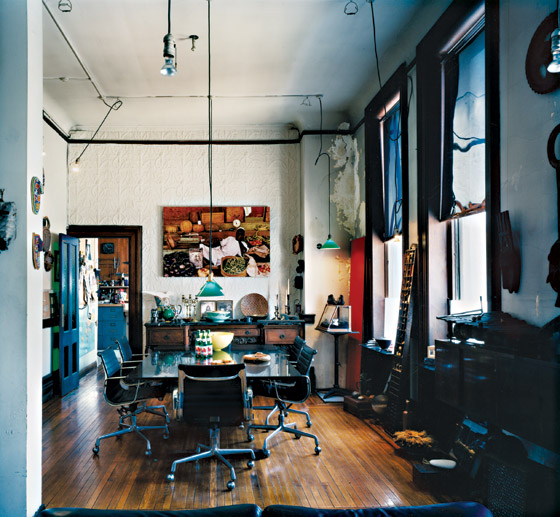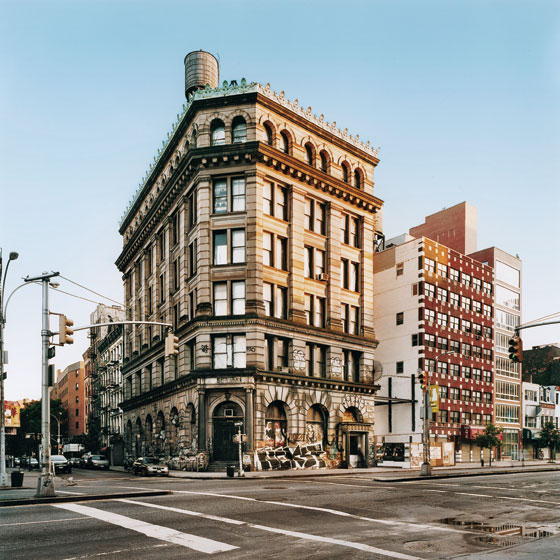


The building at 190 Bowery in New York is a mystery: a graffiti-covered Gilded Age relic, with a beat-up wooden door that looks like it hasn’t been opened since La Guardia was mayor. A few years ago, that described a lot of the neighborhood, but with the Bowery Hotel and the New Museum, the Rogan and John Varvatos boutiques, 190 is now an anomaly, not the norm. Why isn’t some developer turning it into luxury lofts?
Because Jay Maisel, the photographer who bought it 42 years ago for $102,000, still lives there, with his wife, Linda Adam Maisel, and daughter, Amanda. It isn’t a decrepit ruin; 190 Bowery is a six-story, 72-room, 35,000-square-foot single-family home.
In 1966, Maisel was a young artist, paying $125 a month for a 2,500-square-foot studio at 122 Second Avenue. When his landlord raised the rent an unconscionable $50 a month, Maisel went to Jack Klein, a real estate broker. “We took an instant dislike to each other,†says Maisel. But the first property Klein showed Maisel was the abandoned Germania Bank, built in 1898, when the neighborhood was largely middle-class and German. “I said, ‘You got a lot like this?’ †Maisel recalls. “Klein said,
‘This is why I hate photographers. They want the Taj Mahal and they want it for six bucks a month. No, I don’t have a lot like this.’
Interpersonal friction aside, Klein convinced Maisel he could raise the money to buy the abandoned bank. That was the easy part. Then he moved in. The main floor was knee-deep in garbage and coated in soot.
New, the house feels like a dream world, or a benign version of the vast hotel in The Shining. Hallways go on forever. Rooms are filled with projects in various phases of completion. The renovations, mostly done by Maisel, are very “artists live here†style. The air-conditioning, for example, is a building-wide network of giant plastic tubing (the kind used to ventilate greenhouses) that funnels cool air from six units, one on each floor. “It would have cost thousands to put in central air when I moved in,†he explains. The Mylar shades on the windows help keep the heat out; he and Linda make them in one of the rooms on the fifth floor.
Bedrooms, bathrooms, and dining are on the sixth floor; the kitchen was once where the staff cooked meals for the bankers. Linda cooks a lot, but when they do order in, “it’s a riot,†she says. “You have to wait downstairs and watch for the delivery person, because they’ll pass right by. Who is going to think that there is one person ordering from this building? Who wants to leave their bicycle outside?â€
There’s only one elevator, the original copper cage from 1898. It’s gleamingly clean and in excellent working order, though it’s gotten stuck once or twice. “You know what a sign of love is, in this family? It’s if you come home and the elevator is on the ground floor,†says Linda. “Because that means whoever came home before you walked up twelve flights of stairs.â€
What makes this place a magical wonderland (besides the sheer fantastic lunacy of it all) may be the aesthetic decisions cobbled from relatively limited resources. Necessity is the mother of invention, and I love the exposed fixtures, back to basics chrome bars, sleek finishes and natural materials. Everything is functional and harmonious.
A painted wall becomes an exercise in luxury in a space where daily endeavors run more towards maintenance than decor. All of the recycled furnishing — the flat file tables, the laboratory stools, the old and beautiful stove — are charmingly zany but right at home. Not a Saarinen table in sight. It’s so utilitarian that it’s almost shocking in today’s culture of adornment.
He even built his daughter a platform for her bed so that she could watch the skyline at night. And as this image from a student at one of Maisel’s photographic workshops shows, what a skyline it is:
Maisel uses the first, second, and third floors as gallery spaces for his photography and art projects.The fourth floor, which Maisel once rented out to Roy Lichtenstein, is a work-in-progress. The fifth has various workshops, like the Mylar-window-shade room.
But there have been no major changes to the interior. It’s essentially unchanged from the Germania Bank that architect Robert Maynicke designed for the then-bourgeois neighborhood (it cost $200,000 to build). The original safe-deposit vault, still in the basement, is the size of a generous studio apartment; the marks on the main floor where the teller booths once stood are still clearly visible.
The building is its own mini-frontier, and, as of 2005, an official landmark. “Here’s the deal,†Maisel says. “If you have a window that needs fixing, you fix it. If I have a window that is broken, I have to repair it, with approval, the way it was done in 1898.†Upkeep is constant. “A typical day is first we might have to clean the sidewalks,†says Linda. “Because we’re responsible for the sidewalks in front of our building. Or the fire department comes for a walk-through, or the meters need fixing, or the boiler. Or the graffiti police come by.â€
That’s another headache. The city wants the exterior graffiti-free, but it’s impossible: 190 Bowery is a mecca for street artists, as its neighbor 11 Spring was before it went luxury. Maisel tried scrubbing the building every week, but “it was like I was providing a fresh canvas for them.†Keith Haring used to cover the exterior in chalk babies, says Maisel, and that he liked, both for the spirit of the images and because they washed off so easily.
The building is still giving up its secrets. About a month ago, Amanda discovered a room she never knew existed. “It’s kind of in the mezzanine between the first and second floors,†she says. “It’s a cool little room. I don’t know why they don’t use it. It is just kind of full of pieces of mirror.â€
So, will the Maisels ever sell? Or, more to the point, what’s holding them back? By modest estimates, and even in this economy, the building is worth tens of millions of dollars (see the estimates, here), and the property is so prime that sometimes Linda does reconnaissance before she takes out the trash for fear she’ll have to fend off yet another aggressive agent. “One man called me a bitch because I told him the building wasn’t for sale,†she says.
The Maisels are thinking of renting out the first floor, with its polished wooden floors and basketball hoop over the front door (for more information, e-mail info@190thebowery.com). But leaving?
“I fantasize about never having to worry about money again,†Maisel muses. “It would be great to take the money and run. But let’s face it, where are we going to go? A three-room apartment?â€